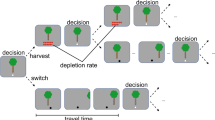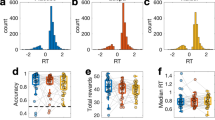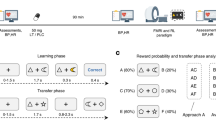Abstract
Continued gambling to recover losses—‘loss chasing’—is a prominent feature of social and pathological gambling. However, little is known about the neuromodulators that influence this behavior. In three separate experiments, we investigated the role of serotonin activity, D2/D3 receptor activity, and beta-adrenoceptor activity on the loss chasing of age and IQ-matched healthy adults randomized to treatment or an appropriate control/placebo. In Experiment 1, participants consumed amino-acid drinks that did or did not contain the serotonin precursor, tryptophan. In Experiment 2, participants received a single 176 μg dose of the D2/D3 receptor agonist, pramipexole, or placebo. In Experiment 3, participants received a single 80 mg dose of the beta-adrenoceptor blocker, propranolol, or placebo. Following treatment, participants completed a computerized loss-chasing game. Mood and heart rate were measured at baseline and following treatment. Tryptophan depletion significantly reduced the number of decisions made to chase losses, and the number of consecutive decisions to chase, in the absence of marked changes in mood. By contrast, pramipexole significantly increased the value of losses chased and diminished the value of losses surrendered. Propranolol markedly reduced heart rate, but produced no significant changes in loss-chasing behavior. Loss chasing can be thought of as an aversively motivated escape behavior controlled, in part, by the marginal value of continued gambling relative to the value of already accumulated losses. Serotonin and dopamine appear to play dissociable roles in the tendency of individuals to gamble to recover, or to seek to ‘escape’ from, previous losses. Serotonergic activity seems to promote the availability of loss chasing as a behavioral option, whereas D2/D3 receptor activity produces complex changes in the value of losses judged worth chasing. Sympathetic arousal, at least as mediated by beta-adrenoceptors, does not play a major role in laboratory-based loss-chasing choices.
Similar content being viewed by others
Log in or create a free account to read this content
Gain free access to this article, as well as selected content from this journal and more on nature.com
or
References
Anderson G, Brown RI (1984). Real and laboratory gambling, sensation-seeking and arousal. Br J Psychol 75 (Part 3): 401–410.
Bari A, Theobald DE, Caprioli D, Mar AC, Aidoo-Micah A, Dalley JW et al (2010). Serotonin modulates sensitivity to reward and negative feedback in a probabilistic reversal learning task in rats. Neuropsychopharmacology 35: 1290–1301 (E-pub ahead of print 27 January 2010).
Ben-Jonathan N (1985). Dopamine: a prolactin-inhibiting hormone. Endocr Rev 6: 564–589.
Bergh C, Eklund T, Sodersten P, Nordin C (1997). Altered dopamine function in pathological gambling. Psychol Med 27: 473–475.
Blaszczynski A, Steel Z, McConaghy N (1997). Impulsivity in pathological gambling: the antisocial impulsivist. Addiction 92: 75–87.
Breen R-B, Zuckerman M (1999). Chasing in gambling behavior: personality and cognitive determinants. Person Individ Differ 92: 1097–1111.
Caine SB, Koob GF, Parsons LH, Everitt BJ, Schwartz JC, Sokoloff P (1997). D3 receptor test in vitro predicts decreased cocaine self-administration in rats. Neuroreport 8: 2373–2377.
Camacho-Ochoa M, Walker EL, Evans DL, Piercey MF (1995). Rat brain binding sites for pramipexole, a clinically useful D3-preferring dopamine agonist. Neurosci Lett 196: 97–100.
Camerer C, Weber M (1992). Recent developments in modeling preferences: uncertainty and ambiguity. J Risk Uncertain 5: 325–370.
Campbell-Meiklejohn DK, Woolrich MW, Passingham RE, Rogers RD (2008). Knowing when to stop: the brain mechanisms of chasing losses. Biol Psychiatry 63: 293–300.
Cools R, Robinson OJ, Sahakian B (2008). Acute tryptophan depletion in healthy volunteers enhances punishment prediction but does not affect reward prediction. Neuropsychopharmacology 33: 2291–2299.
Corless T, Dickerson M (1989). Gamblers’ self-perceptions of the determinants of impaired control. Br J Addict 84: 1527–1537.
Crockett MJ, Clark L, Robbins TW (2009). Reconciling the role of serotonin in behavioral inhibition and aversion: acute tryptophan depletion abolishes punishment-induced inhibition in humans. J Neurosci 29: 11993–11999.
Cubitt R, Starmer C, Sugden R (1998). On the validity of the random lottery incentive system. Exp Econ 1: 115–131.
Dagher A, Robbins TW (2009). Personality, addiction, dopamine: insights from Parkinson's disease. Neuron 61: 502–510.
Daw ND, Kakade S, Dayan P (2002). Opponent interactions between serotonin and dopamine. Neural Netw 15: 603–616.
Dayan P, Huys QJ (2008). Serotonin, inhibition, and negative mood. PLoS Comput Biol 4: e4.
Deakin JFW, Graeff FG (1991). 5-HT and mechanisms of defence. J Psychopharmacol 5: 305–315.
Dickerson M, Hinchy J, Fabre J (1987). Chasing, arousal and sensation seeking in off-course gamblers. Br J Addict 82: 673–680.
Evers EA, Cools R, Clark L, van der Veen FM, Jolles J, Sahakian BJ, et al (2005). Serotonergic modulation of prefrontal cortex during negative feedback in probabilistic reversal learning. Neuropsychopharmacology 30: 1138–1147.
Frank MJ (2006). Hold your horses: a dynamic computational role for the subthalamic nucleus in decision making. Neural Netw 19: 1120–1136.
Frank MJ, O’Reilly RC (2006). A mechanistic account of striatal dopamine function in human cognition: psychopharmacological studies with cabergoline and haloperidol. Behav Neurosci 120: 497–517.
Frank MJ, Moustafa AA, Haughey HM, Curran T, Hutchison KE (2007a). Genetic triple dissociation reveals multiple roles for dopamine in reinforcement learning. Proc Natl Acad Sci USA 104: 16311–16316.
Frank MJ, Samanta J, Moustafa AA, Sherman SJ (2007b). Hold your horses: impulsivity, deep brain stimulation, and medication in parkinsonism. Science 318: 1309–1312.
Frank MJ, Doll BB, Oas-Terpstra J, Moreno F (2009). Prefrontal and striatal dopaminergic genes predict individual differences in exploration and exploitation. Nat Neurosci 12: 1062–1068.
Grace AA (1995). The tonic/phasic model of dopamine system regulation: its relevance for understanding how stimulant abuse can alter basal ganglia function. Drug Alcohol Depend 37: 111–129.
Grant JE, Potenza MN (2006). Escitalopram treatment of pathological gambling with co-occurring anxiety: an open-label pilot study with double-blind discontinuation. Int Clin Psychopharmacol 21: 203–209.
Grant JE, Kim SW, Odlaug BL (2007). N-acetyl cysteine, a glutamate-modulating agent, in the treatment of pathological gambling: a pilot study. Biol Psychiatry 62: 652–657.
Grant JE, Kim SW, Hollander E, Potenza MN (2008). Predicting response to opiate antagonists and placebo in the treatment of pathological gambling. Psychopharmacology (Berl) 200: 521–527.
Hamidovic A, Kang UJ, de Wit H (2008). Effects of low to moderate acute doses of pramipexole on impulsivity and cognition in healthy volunteers. J Clin Psychopharmacol 28: 45–51.
Hewig J, Kretschmer N, Trippe RH, Hecht H, Coles MG, Holroyd CB et al (2010). Hypersensitivity to reward in problem gamblers. Biol Psychiatry 67: 781–783.
Kahneman D, Tversky A (2000). Choices Values and Frames. Cambridge University Press: Cambridge, UK.
Lesieur H (1977). The Chase: Career of the Compuslive Gambler, 1st edn. Anchor Press/Doubleday: Garden City, NY.
Lesieur HR (1979). The compulsive gambler's spiral of options and involvement. Psychiatry 42: 79–87.
Lesieur HR, Blume SB (1987). The South Oaks Gambling Screen (SOGS): a new instrument for the identification of pathological gamblers. Am J Psychiatry 144: 1184–1188.
Manconi M, Ferri R, Zucconi M, Oldani A, Fantini ML, Castronovo V et al (2007). First night efficacy of pramipexole in restless legs syndrome and periodic leg movements. Sleep Med 8: 491–497.
McBride O, Adamson G, Shevlin M (2010). A latent class analysis of DSM-IV pathological gambling criteria in a nationally representative British sample. Psychiatry Res 178: 401–407.
Meyer G, Hauffa BP, Schedlowski M, Pawlak C, Stadler MA, Exton MS (2000). Casino gambling increases heart rate and salivary cortisol in regular gamblers. Biol Psychiatry 48: 948–953.
Murphy S, Longhitano C, Ayres R, Cowen P, Harmer C, Rogers R (2009). The role of serotonin in non-normative risky choice: the effects of tryptophan supplements on the ‘reflection effect’ in healthy adult volunteers. J Cogn Neurosci 21: 1709–1719.
Nakano K, Kayahara T, Tsutsumi T, Ushiro H (2000). Neural circuits and functional organization of the striatum. J Neurol 247 (Suppl 5) V1: 15.
Pallanti S, Bernardi S, Quercioli L, DeCaria C, Hollander E (2006). Serotonin dysfunction in pathological gamblers: increased prolactin response to oral m-CPP versus placebo. CNS Spectr 11: 956–964.
Pallesen S, Molde H, Arnestad HM, Laberg JC, Skutle A, Iversen E et al (2007). Outcome of pharmacological treatments of pathological gambling: a review and meta-analysis. J Clin Psychopharmacol 27: 357–364.
Pizzagalli DA, Evins AE, Schetter EC, Frank MJ, Pajtas PE, Santesso DL et al (2008). Single dose of a dopamine agonist impairs reinforcement learning in humans: behavioral evidence from a laboratory-based measure of reward responsiveness. Psychopharmacology (Berl) 196: 221–232.
Potenza MN (2008). Review. The neurobiology of pathological gambling and drug addiction: an overview and new findings. Philos Trans R Soc Lond Ser B 363: 3181–3189.
Raven JC, Court HJ, Raven J (1998). Manual for Raven's Progressive Matrices and Vocabulary Scales. Harcourt Assessment: San Antonio, TX.
Reuter J, Raedler T, Rose M, Hand I, Glascher J, Buchel C (2005). Pathological gambling is linked to reduced activation of the mesolimbic reward system. Nat Neurosci 8: 147–148.
Riba J, Rodriguez-Fornells A, Morte A, Munte TF, Barbanoj MJ (2005). Noradrenergic stimulation enhances human action monitoring. J Neurosci 25: 4370–4374.
Riba J, Kramer UM, Heldmann M, Richter S, Munte TF (2008). Dopamine agonist increases risk taking but blunts reward-related brain activity. PLoS One 3: e2479.
Rogers RD, Lancaster M, Wakeley J, Bhagwagar Z (2004). Effects of beta-adrenoceptor blockade on components of human decision-making. Psychopharmacology (Berl) 172: 157–164.
Rogers RD, Moeller FG, Swann AC, Clark L (2010). Recent research on impulsivity in individuals with drug use and mental health and disorders: implications for alcoholism. Alcohol Clini Exp Res 34: 1319–1333.
Roy A, Adinoff B, Roehrich L, Lamparski D, Custer R, Lorenz V et al (1988). Pathological gambling. A psychobiological study. Arch Gen Psychiatry 45: 369–373.
Sacco P, Torres LR, Cunningham-Williams RM, Woods C, Unick GJ (2010). Differential item functioning of pathological gambling criteria: an examination of gender, race/ethnicity, and age. J Gambl Stud.
Santesso DL, Evins AE, Frank MJ, Schetter EC, Bogdan R, Pizzagalli DA (2009). Single dose of a dopamine agonist impairs reinforcement learning in humans: evidence from event-related potentials and computational modeling of striatal–cortical function. Hum Brain Mapp 30: 1963–1976.
Schilling JC, Adamus WS, Palluk R (1992). Neuroendocrine and side effect profile of pramipexole, a new dopamine receptor agonist, in humans. Clin Pharmacol Therapeut 51: 541–548.
Shaffer HJ, Korn DA (2002). Gambling and related mental disorders: a public health analysis. Annu Rev Public Health 23: 171–212.
Shafir E, Tversky A (1995). Decision Making, In: Smith EE, Oscherson DN (eds). Thinking. MIT Press: Cambridge, MA. pp 77–100.
Soubrie P (1986). Serotonergic neurons and behavior. J Pharmacol 17: 107–112.
Thiel KJ, Wenzel JM, Pentkowski NS, Hobbs RJ, Alleweireldt AT, Neisewander JL (2010). Stimulation of dopamine D2/D3 but not D1 receptors in the central amygdala decreases cocaine-seeking behavior. Behav Brain Res 214: 386–394 (E-pub ahead of print 19 June 2010).
van der Veen FM, Mies GW, van der Molen MW, Evers EA (2008). Acute tryptophan depletion in healthy males attenuates phasic cardiac slowing but does not affect electro-cortical response to negative feedback. Psychopharmacology (Berl) 199: 255–263.
van Eimeren T, Ballanger B, Pellecchia G, Miyasaki JM, Lang AE, Strafella AP (2009). Dopamine agonists diminish value sensitivity of the orbitofrontal cortex: a trigger for pathological gambling in Parkinson's disease? Neuropsychopharmacology 34: 2758–2766.
Voon V, Thomsen T, Miyasaki JM, de Souza M, Shafro A, Fox SH et al (2007). Factors associated with dopaminergic drug-related pathological gambling in Parkinson disease. Arch Neurol 64: 212–216.
Voon V, Pessiglione M, Brezing C, Gallea C, Fernandez HH, Dolan RJ et al (2010). Mechanisms underlying dopamine-mediated reward bias in compulsive behaviors. Neuron 65: 135–142.
Watson D, Clark LA, Tellegen A (1988). Development and validation of brief measures of positive and negative affect: the PANAS scales. J Pers Soc Psychol 54: 1063–1070.
Winstanley CA, Dalley JW, Theobald DE, Robbins TW (2004). Fractionating impulsivity: contrasting effects of central 5-HT depletion on different measures of impulsive behavior. Neuropsychopharmacology 29: 1331–1343.
Zack M, Poulos CX (2004). Amphetamine primes motivation to gamble and gambling-related semantic networks in problem gamblers. Neuropsychopharmacology 29: 195–207.
Zack M, Poulos CX (2007). A D2 antagonist enhances the rewarding and priming effects of a gambling episode in pathological gamblers. Neuropsychopharmacology 32: 1678–1686 (E-pub ahead of print 3 January 2007).
Zeeb FD, Robbins TW, Winstanley CA (2009). Serotonergic and dopaminergic modulation of gambling behavior as assessed using a novel rat gambling task. Neuropsychopharmacology 34: 2329–2343.
Zhong S, Israel S, Xue H, Sham PC, Ebstein RP, Chew SH (2009). A neurochemical approach to valuation sensitivity over gains and losses. Proc Biol Sci 276: 4181–4188.
Acknowledgements
This research was funded by a Medical Research Council studentship to Daniel Campbell-Meiklejohn and by an independent award from the Biotechnology and Biological Sciences Research Council (BBSRC) to Robert Rogers. We would also like to thank Michael Frank for helpful suggestions about an earlier version of this manuscript.
Author information
Authors and Affiliations
Corresponding author
Ethics declarations
Competing interests
We report no biomedical financial interests or potential conflicts of interest.
Additional information
Supplementary Information accompanies the paper on the Neuropsychopharmacology website
Supplementary information
Rights and permissions
About this article
Cite this article
Campbell-Meiklejohn, D., Wakeley, J., Herbert, V. et al. Serotonin and Dopamine Play Complementary Roles in Gambling to Recover Losses. Neuropsychopharmacol 36, 402–410 (2011). https://doi.org/10.1038/npp.2010.170
Received:
Revised:
Accepted:
Published:
Issue date:
DOI: https://doi.org/10.1038/npp.2010.170
Keywords
This article is cited by
-
The Global Prevalence of Problem and Pathological Gambling and Its Associated Factors Among Individuals with Substance Use Disorders: A Meta-analysis
International Journal of Mental Health and Addiction (2023)
-
Influences of social uncertainty and serotonin on gambling decisions
Scientific Reports (2022)
-
Neuromodulation of prefrontal cortex cognitive function in primates: the powerful roles of monoamines and acetylcholine
Neuropsychopharmacology (2022)
-
Serotonin modulates asymmetric learning from reward and punishment in healthy human volunteers
Communications Biology (2022)
-
Effects of 5-HT2C, 5-HT1A receptor challenges and modafinil on the initiation and persistence of gambling behaviours
Psychopharmacology (2020)



